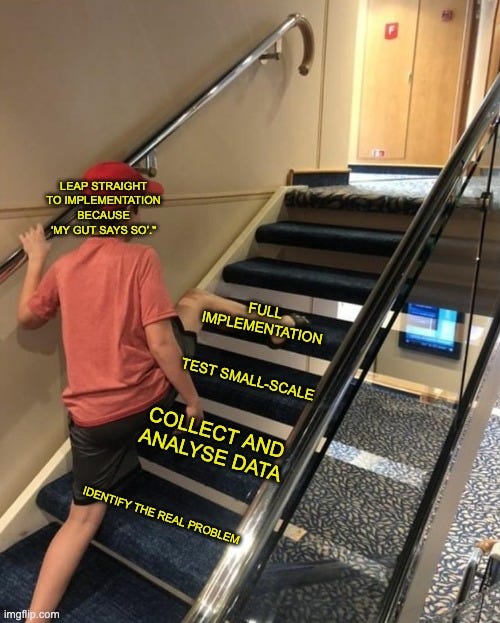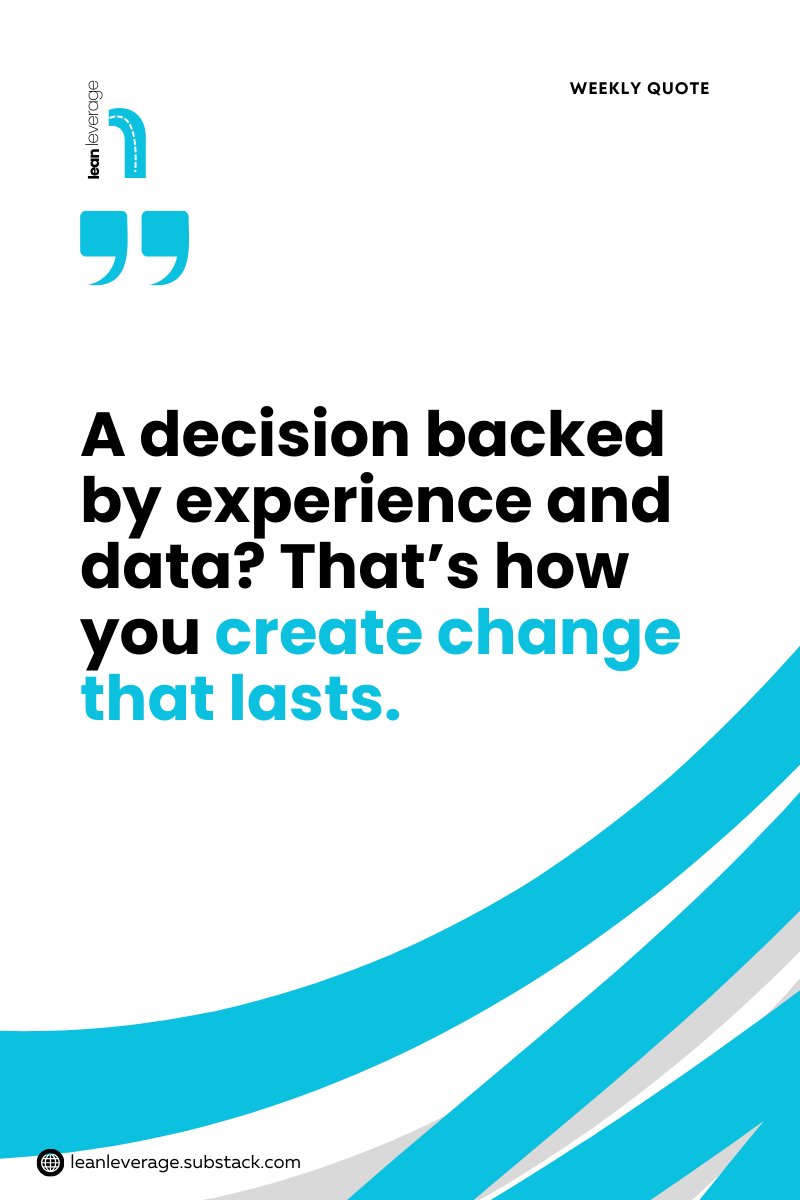“Experienced Intuition” is Not Enough
A decision backed by experience and data? That’s how you create change that lasts.
Hey friend,
Before we get into today’s post, here’s a rare photo of what you look like when you rely solely on “experienced intuition” and gut feeling for decision-making. If this is your sub, please, catch it.
There’s a popular proverb: “Experience is the best teacher.”
It’s the same thinking behind those job ads that look perfect, until you scroll down and see “12 years of experience required” and instantly feel the cold hand of the “Unfortunately…” email on your shoulder.
Experience is valuable. I’m not here to fight that. Historically, it’s how most business decisions were made: gut feeling, war stories, and a healthy dose of “this worked for us in ‘87.”
The problem? Somewhere along the line, we started treating experience and intuition as the only teachers worth listening to. And that’s where things start to wobble.
What is “Experienced Intuition”?
Let’s start with intuition itself.
According to Cambridge.org, intuition is the ability to understand or know something immediately based on feelings rather than facts. We all have some of it; that inner radar that tells you if a situation feels safe or sketchy, or if an opportunity smells right.
It’s the same one that told you Femi was not the man for you, but you resisted.
Now, experienced intuition is what happens when that gut feeling is backed by years of knowledge, education, and industry scars. Roeder, T. (2010). describes it as the ability to decide “what’s best” without consciously working through the details, simply because you’ve seen it before.
That’s why seasoned professionals often say, “I just knew it was the right thing to do.”
But when it comes to improving processes, is just experienced intuition enough? My answer: No. Here’s why.
The Trouble With Following Just Your Intuition
Lean and Six Sigma aren’t here to tell you your instincts are wrong. They’re here to give them a backbone, a statistical, data-driven, mathematically sober check that either validates your hunch or politely bursts the bubble.
Your gut might say: “This change will revolutionise our product or service.”
A proper improvement methodology will ask: “Do the numbers agree?”
Without that check, decision-making often looks like this:
A manager has an idea or a hunch.
The idea reaches an executive.
The executive shares it with other senior leaders.
Everyone nods because “it worked that one time back in ’94.”
A small-scale “test” happens — but only for the problems they already know about.
The idea is launched on a large scale.
Success is declared. Champagne is poured.
It’s basically running a PDSA cycle with the Plan tossed in the bin, and the Study scribbled on a piece of toilet paper afterwards.
Why This Is Risky
1. Blind Spots Multiply
Experienced intuition is powerful, but it’s still limited to what you’ve personally seen. That creates blind spots big enough to drive a truck through.
You fix the checkout queue, but now the parking lot is a nightmare.
You speed up production, but defects double.
You add a feature customers love, and complaints spike in a totally different area.
Skipping proper analysis means you find problems after they’ve annoyed customers, and by then, they’re harder (and perhaps more expensive) to fix.
2. Motives Go Unchecked
Without structured analysis, you can’t be sure the idea or change is even necessary in the first place.
Is it solving a real problem?
Do you have the resources to sustain it?
What happens if you do nothing?
Some ideas look brilliant in a boardroom and collapse the moment they touch reality.
It’s like looking great in real life but ending up with a passport photo that could get you stopped at customs.
Improvement Methodologies Are Not “Juju”
Even with all the data in the world, you can’t predict every risk. But a structured method dramatically reduces surprises and gives you a map of your possibilities before you start.
The aim is not to kill your ideas but to make sure they don’t become headaches for the business.
The process is simple in principle:
Validate that there’s a real problem.
Consider what could go wrong.
Talk to the veterans who’ve been there before.
And then check the numbers.
Pair your experienced intuition with data, and you’ll make decisions that are durable, scalable, and defensible.
The Wrap-Up
Experience and intuition are gold. But pure gold is soft, so you have to mix it with the steel of data and methodology to make it strong enough to build with.
A decision backed only by experienced intuition? That’s like building a house with mud in the swamp.
A decision backed by experience and data? That’s how you create change that lasts.
That’s my take, but if you believe intuition alone is enough, I’m curious. Drop your thoughts in the comments.
Tomiwa,
Improvement Enthusiast
References:
Intuition. (n.d.). In cambridge.org. Retrieved August 15, 2025, from https://dictionary.cambridge.org/dictionary/english/intuition
Roeder, T. (2010, October 12). Sixth Sense Intuition: A white paper in the series on a Sixth Sense for Project Management®. Project Management Institute. Retrieved August 15, 2025, from https://www.pmi.org/learning/library/sixth-sense-intuition-project-management-6601#:~:text=Intuition%20will%20help%20deliver%20those,better%20job%20delivering%20project%20results.
Paper presented at PMI® Global Congress 2010—North America, Washington, DC.Newtown Square, PA: Project Management Institute.





I love the idea that intuition has to be balanced by other modes of evaluating decisions. The comment about the softness of pure gold is a great analogy! Also, I think that, as part of having different gifts, humans have better intuition in some areas than others. I had great intuition for improving my students college application essays. But I had lousy intuition for starting businesses I actually enjoyed. So I'm all for the idea that intuition is one tool in a portfolio that can lead to success.
Great topic Tomiwa
Data is always critical in making informed decisions!